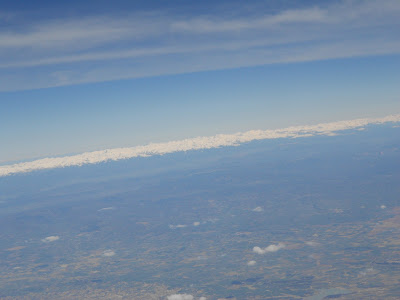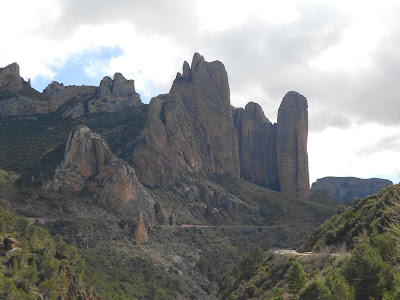On Good Friday, I went out with GAS for a bit of birding in Staffordshire. We visited Aqualate and Branston, but both sites were quiet. The summer migrants hadn't arrived yet, and there were no new birds coming into the area. We didn't really see much.
PJ had suggested an Easter weekend trip, and with the prospects for Staffs looking bleak, we decided to go ahead. With the BLACK-BELLIED DIPPERS still lingering around Thetford, Norfolk, we headed down there for the day. It was the first time this year that the four of us were out on a trip. We set off at 05:00hrs, arriving just over three hours later. It was breezy and cool, and throughout the day we had frequent snow showers.
We decided to be ambitious and go for four target birds and Breckland specialities - Golden Pheasant, Stone-curlew, Goshawk and the Black-bellied Dipper.
First stop was for Golden Pheasant. We found a place to park and started to walk through the wood. We were all scanning away when in the distance I spotted a male Golden Pheasant walking through the undergrowth. I babbled out directions, but the Golden Pheasant was slowly dropping down a slope, then disappeared behind a tree and never came out again. We moved position but despite hearing it call several times, we never saw it again. First target birds are important to get the day off to a flyer, and when only one member of the group sees a bird, its not a good start.
Then it was off to Thetford for the long staying Black-bellied Dipper. PJ was also keen to catch up with the Otters that were present here. We managed to get a space in the car park as one car drove out, but the area was heaving with blokes with scopes in camouflaged coats, and blokes with massive lenses, no bins and camouflaged coats. Every little stretch of stream and every bridge had someone in position, ready and poised. PJ asked a returning long lens boy/birder if it was showing. The man gave PJ directions and off he hurtled upstream. As I tagged along behind (I'm able to keep up with him now with my new improved ticker) I discovered we were off to see the Otters first.
It hadn't been a succesful start to the day really. A group decision was made and we headed off to see Stone-curlew. We arrived at the site, but the weather had turned a little, and it was now dull and quite windy. At first there was no sign of any Stone-curlews (we did think it was a wee bit early for them), but with careful scanning, I soon found two birds sheltering from the wind, and this time, I managed to get everyone on them.
At last, we all had seen something, and despite the slightly unsuitable weather, we decided to go and try for Goshawk. As we drove there, the sky went black and we had another blizzard. Fortunately, we parked up just as it stopped and we had a pleasant walk to the watchpoint. We had only been on site for a few minutes when a Goshawk, probably a male, appeared and started to circle around over one of the woods. It eventually disappeared and there was no further sign.
We had about an hour left before we had to head for home. We called back in to see if the Golden Pheasant had stopped hiding. Afternoons are never the best for these, but despite hearing one again, we didn't see it. We then called into Thetford again. Still full of birders/long lens boys. We parked up, asked a bloke who was putting his stuff back in the boot if the Dipper had been seen yet, but it hadn't. We called it a day and headed for home. (The Black-bellied Dipper was eventually found about 1km west of the town centre. We wondered if the volume of people in the area had pushed it out or not).
All day long we had seen muntjac wherever we went. An amazing number were seen. This one was seen feeding at the rear of the Esso Station on the A11, feeding off bits that had fallen out of the bin.
Here is a Black-bellied Dipper I saw earlier - Back in February 2008 in Yorkshire. This was also on a narrow, slow flowing stream, but in the countryside.
We decided to be ambitious and go for four target birds and Breckland specialities - Golden Pheasant, Stone-curlew, Goshawk and the Black-bellied Dipper.
First stop was for Golden Pheasant. We found a place to park and started to walk through the wood. We were all scanning away when in the distance I spotted a male Golden Pheasant walking through the undergrowth. I babbled out directions, but the Golden Pheasant was slowly dropping down a slope, then disappeared behind a tree and never came out again. We moved position but despite hearing it call several times, we never saw it again. First target birds are important to get the day off to a flyer, and when only one member of the group sees a bird, its not a good start.
Then it was off to Thetford for the long staying Black-bellied Dipper. PJ was also keen to catch up with the Otters that were present here. We managed to get a space in the car park as one car drove out, but the area was heaving with blokes with scopes in camouflaged coats, and blokes with massive lenses, no bins and camouflaged coats. Every little stretch of stream and every bridge had someone in position, ready and poised. PJ asked a returning long lens boy/birder if it was showing. The man gave PJ directions and off he hurtled upstream. As I tagged along behind (I'm able to keep up with him now with my new improved ticker) I discovered we were off to see the Otters first.
As I arrived at the small crowd of long lens boys, the Otter had plopped into the stream. The long lens boys then started running down stream, stopping off at various vantage points and bends. Some of them hurled themselves to the ground and lay flat, long lens poised. The Otter then popped his head up and the clicking would start. Sometimes the Otter came out on the bank showing down to a few feet, and the carefully positioned ones would get another magnificent full frame shot to go with their 400 other magnificent full frame shots. It did become a bit of a stampede as the Otter swam downstream. Digiscoping with my scope wasn't too success, but PJ with his short long lens camera did score with a frame filler. It was an incredible experience to watch an Otter at such close quarters. (CJW and myself did wonder if it was going to jump thru any hoops or balance a ball on its nose at anythime, but it didn't. We didn't even dare try the bread test!)
This was my best attempt - but it does show PJ taking the photo below
Otter at Thetford by PJ
Another shot by PJ as it came out on the bank opposite
The Otter eventually went onto a part of the river with no access and all the long lens boys came to a shuddering halt and ended up in a heap on the floor. We then started to try and find the long staying Black-bellied Dipper. No one who we spoke to had seen the bird yet today, but there were rumours that it had been seen earlier on, although there were no messages on any of the pagers confirming this. We wandered around, checking quite a few different spots, but with the only suitable streams being very small, narrow and with birders walking along side them, we didn't hold out much hope.
It hadn't been a succesful start to the day really. A group decision was made and we headed off to see Stone-curlew. We arrived at the site, but the weather had turned a little, and it was now dull and quite windy. At first there was no sign of any Stone-curlews (we did think it was a wee bit early for them), but with careful scanning, I soon found two birds sheltering from the wind, and this time, I managed to get everyone on them.
A Stone-curlew not showing well
GAS made all the effort to walk to the Watchpoint and then someone goes and stands in front of him
Fieldcraft at its best - The Clayheads waiting for Goshawk, using the logs as camouflage to break up the outline seats
We had about an hour left before we had to head for home. We called back in to see if the Golden Pheasant had stopped hiding. Afternoons are never the best for these, but despite hearing one again, we didn't see it. We then called into Thetford again. Still full of birders/long lens boys. We parked up, asked a bloke who was putting his stuff back in the boot if the Dipper had been seen yet, but it hadn't. We called it a day and headed for home. (The Black-bellied Dipper was eventually found about 1km west of the town centre. We wondered if the volume of people in the area had pushed it out or not).
All day long we had seen muntjac wherever we went. An amazing number were seen. This one was seen feeding at the rear of the Esso Station on the A11, feeding off bits that had fallen out of the bin.
Muntjac by Phil Jones
Here is a Black-bellied Dipper I saw earlier - Back in February 2008 in Yorkshire. This was also on a narrow, slow flowing stream, but in the countryside.

















































